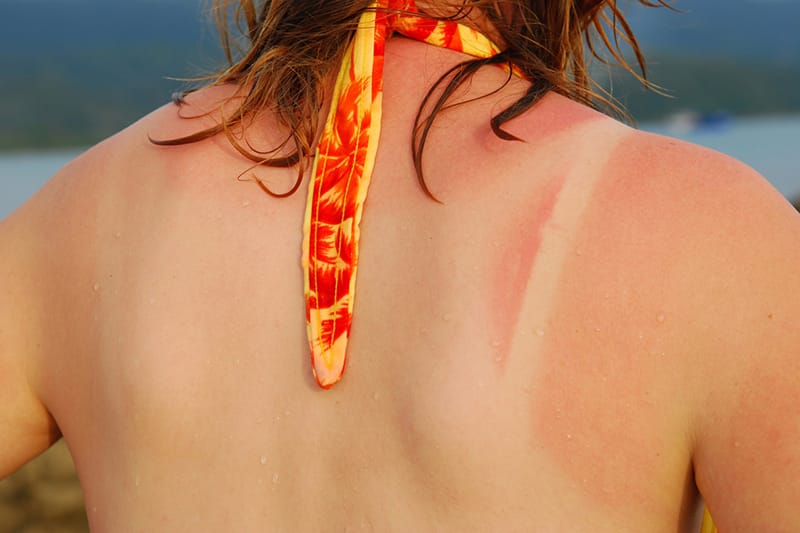We all know what the sun can do to our skin. But despite the risks of skin cancer, many people still prefer to catch some rays rather than protect against them. Others give it their best shot but get burned.
If you know what you’re supposed to do but still find it hard to follow through, you’re not the only one. Each year, more than one-third of adults suffer a sunburn, according to a study in the Journal of the American Medical Association. And half of them get burned more than once.
It happens. Fun in the sun distracts you from the dangers it poses. You lose track of time and forget to reapply sunscreen or move to a shadier spot. You end up with skin in shades of red and in search of relief.
Sunburn treatment should start as soon as your skin changes color.
“Cool your skin off as quickly as possible," says North Waukee Dermatology provider Morgan McGinn, PA-C. "Mix ice and aloe vera together and apply on the sore skin - it works wonders! Avoid picking and popping the blisters and flaking skin.”
The longer you stay outside and in the sunshine, the worse your sunburn will get. Often, you don’t notice your changing skin tone until you’re inside and the day is done. But if you spot pink or red skin, stay out of the sun and start treating your burn with these tips:
- Cool down in the tub or shower. Sunburns can be painful. Your skin is hot and tender to the touch. Cooling down your skin by jumping in the shower or bathtub can provide quick pain relief.
- Apply moisturizer. When you hop out of the cold water, don’t completely dry yourself off. Leave your skin a little damp and trap the moisture on your skin by applying a moisturizing lotion. Use a product that contains aloe vera or soy to help soothe your skin.
- Rehydrate. Your burnt skin is dry, so your body takes water from other areas and brings it to the skin’s surface to help it heal. Drink extra water to keep your whole body hydrated and to help prevent peeling.
- Take pain relievers as needed. For particularly painful sunburns, take acetaminophen or ibuprofen to reduce your discomfort and swelling. Topical hydrocortisone creams can more directly ease the pain on any uncomfortable areas.
- Be gentle. Your skin is recovering. Avoid anything that will irritate it or cause it to peel. Use soft washcloths, pat instead of scrub and wear softer clothing. Stay away from harsh cleansers, exfoliators or creams that contain petroleum, benzocaine or lidocaine.
Severe sunburns may require more than a home remedy.
Redness, swelling, tenderness, burning, tightness — your skin can show a variety of symptoms. Even peeling is a common side effect of a first-degree sunburn.
If your skin begins to blister, that means you’ve experienced a second-degree burn. Severe sunburns damage the deeper layers of your skin. Blisters are your body’s way of rehydrating and repairing the damage. So don’t pop them! Not only will this delay healing; it could open your skin to infection.
Second-degree sunburns can also lead to other issues. Go to the doctor if you:
- Have blisters over a large area of your body.
- Run a fever.
- Get the chills.
- Feel dizzy, woozy, weak or nauseous.
- See oozing pus or red streaks coming from the blisters.
- Experience a lot of pain.
These won’t be the worst of your issues if you’re a repeat offender. Just one bad sunburn increases your risk of skin aging and skin cancer. The more severe, blistering sunburns you get, the greater your risk.
Take special precautions if you’re out in the sun.
By now, you’ve probably heard all the advice:
- Wear sunscreen.
- Reapply it every couple of hours.
- Stay in the shade.
- Wear long clothes and wide-brimmed hats.
- Avoid the worst ultraviolet rays in the middle of the day.
But if you’ve been relying solely on sunscreen, you need to add more methods to the mix or become more diligent in your application. Especially if you have fair skin or are more susceptible to sunburns.
A layer of sunscreen can give you a false sense of confidence that extends your time outside and leaves you more exposed to UV rays. And if you’re exercising, swimming or just sweating out a steamy Iowa summer day, your sunscreen is wearing off faster than you think.
Sunscreen is intended to be used along with other sun protection methods, not as a replacement for them. So slather it on often, cover up exposed skin and hang out in the shade. Because the more protection you can give your skin, the less chance you’ll be left red-faced.


